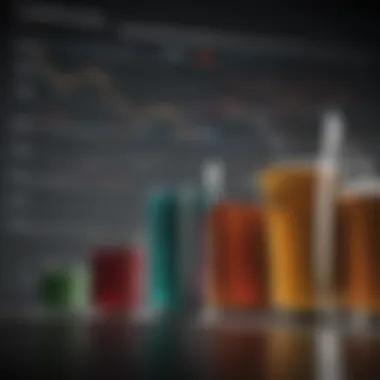Top Alcohol Stocks: Market Performance and Growth Potential


Market Overview
Current Market Conditions
The alcohol industry has displayed remarkable resilience in recent years, especially in volatile market environments. Following the disruptions caused by the COVID-19 pandemic, the sector has gradually returned to stability. Consumer preferences have shifted, leading to the rise of craft beverages and premium products. The market is expected to expand steadily as brands innovate to meet changing consumer demands.
Key Economic Indicators
Several indicators play a crucial role in assessing the health of the alcohol market. These include GDP growth rates, unemployment levels, and disposable income trends. As economies recover, increased personal spending capabilities will likely drive alcohol consumption and sales.
Major Market Trending Factors
- Health Consciousness: There’s a growing demand for low-alcohol and non-alcoholic alternatives. This trend reshapes product development in the sector.
- Sustainability Movements: Brands are increasingly focusing on environmentally friendly practices, appealing to more aware consumers.
- E-commerce Growth: The digital transformation in retail has facilitated the easy purchase of alcohol, greatly influencing consumer behavior.
The convergence of these trends signals a pivotal period for alcohol stocks, promising diverse investment opportunities.
Stock Analysis
Stock Performance Review
Evaluating stock performance in the alcohol sector involves examining historical price changes and volatility. Leading companies have shown significant performance variations, correlated closely with broader market shifts and consumer behaviors.
Fundamental Analysis
Fundamental analysis focuses on several key metrics:
- PE Ratios: This ratio indicates how much investors are willing to pay per dollar of earnings. A lower PE ratio may signal a potential undervaluation.
- Dividend Yields: Many alcohol companies are known for providing dividends, making them attractive for income-seeking investors.
Technical Analysis
Technical analysis relies on chart patterns and indicators to assess possible future price movements. Commonly used tools include:
- Moving Averages: These smooth price data to identify trends over specific periods.
- Relative Strength Index (RSI): This indicator measures the speed and change of price movements to identify overbought or oversold conditions.
Investment Strategies
Long-Term vs Short-Term Investing
Investors need to evaluate their goals. Long-term strategies might focus on established companies with a history of stable returns, while short-term trading could take advantage of price fluctuations based on news and market trends.
Value vs Growth Investing
- Value Investing: This approach aims to identify undervalued companies with potential for higher returns.
- Growth Investing: This strategy focuses on companies expected to grow rapidly, even if their stock prices appear high relative to earnings.
Risk Management Techniques
Diversifying portfolios can help mitigate risks associated with alcohol stocks. Periodic reviews of investments are essential to adjust strategies based on market dynamics.
Recommended Stocks
Top Stock Picks for the Month
- Constellation Brands
- Diageo plc
- Molson Coors Beverage Company
Sector-Wise Recommendations
Investment may also vary by sector, considering:
- Premium brands for potential high growth.
- Established players for stable dividends.
Emerging Stocks to Watch


Keep an eye on up-and-coming brands that show promise in niche markets, particularly those that align with health trends and sustainability.
Financial Education Resources
Articles and Guides for Beginners
New investors should consider starting with resources that cover fundamental concepts of stock investing.
Advanced Investment Strategies
For experienced investors, resources focusing on specific investment strategies and market analysis can offer deeper insights.
Tools for Financial Planning
Utilizing financial planning tools can aid individuals in making informed decisions regarding their alcohol stock investments.
Prologue to Alcohol Stocks
Investing in alcohol stocks offers unique opportunities and insights into a resilient sector that tends to withstand economic fluctuations. The alcohol market is large and diverse. It encompasses various segments, from craft breweries to large multinational beverage companies. Understanding this sector can enable investors to make informed decisions, particularly in a changing economic landscape.
Understanding Alcohol Stock Market Trends
Market trends in the alcohol industry reflect consumer preferences, regulatory changes, and economic variables. In recent years, there has been a notable shift towards premium products and craft options. Consumers, especially younger demographics, increasingly favor personalized, high-quality experiences over mass-market products. Reports show that regions where craft breweries have flourished experienced substantial growth in local economies.
Another trend is the rise of health consciousness among consumers. This includes a concern for lower-calorie options and organic or gluten-free beverages. Alcohol brands have been adapting their portfolios to include these options. Observably, companies that innovate and align with consumer demands tend to report stronger performance.
Investors should be aware that the alcohol market, while stable, is not immune to volatility. Economic downturns can impact sales. Still, historical data shows that alcohol consumption often remains steady even during economic hardships. This characteristic can make alcohol stocks a more stable investment compared to other sectors.
Relevance of Alcohol Stocks in Investment Portfolios
Alcohol stocks can add significant value to an investment portfolio. Their ability to generate consistent returns, even during recessions, provides a level of diversification. This characteristic is appealing for risk-averse investors. Moreover, dividends paid by major alcohol companies often attract income-seeking investors.
When considering allocation to alcohol stocks, investors should look at both established brands and emerging players. Established companies like Anheuser-Busch InBev and Diageo offer stability, while startups can provide growth potential. Balancing these in a portfolio can enhance overall performance.
Key Players in the Alcohol Industry
Understanding the key players in the alcohol industry is crucial for any investor aiming to navigate this complex market. Major companies and emerging brands both play significant roles in shaping trends and influencing stock performance. The dynamics between well-established corporations and newer entrants provide a comprehensive overview of market health and growth potential.
Investors must evaluate these players not only for their current market share but also for their adaptability in a continuously evolving environment. Consumer preferences, regulatory challenges, and technological advancements all impact how these companies operate.
Major Corporations Overview
The alcohol industry is dominated by several major corporations known for their expansive portfolios and global reach. Companies such as Anheuser-Busch InBev, Diageo, and Constellation Brands have established themselves as leaders. Their brand recognition and financial stability make them attractive to investors.
- Anheuser-Busch InBev: This conglomerate is the world's largest brewer. It owns a range of brands, including Budweiser and Corona. It has a strong presence in several international markets, giving it leverage during economic shifts.
- Diageo: Known for its broad selection of spirits, this company includes brands like Johnnie Walker and Smirnoff in its portfolio. Diageo's focus on premium spirits has allowed it to capture a significant share of the luxury market.
- Constellation Brands: This firm is a major player in the beverage alcohol sector. Particularly known for its wine and beer operations, it owns and manages several popular brands, including Corona and Robert Mondavi wines.
These corporations often show resilience during economic downturns due to their diversified products and established market positions. However, as they grow, they also face unique challenges such as changing consumer preferences towards healthier lifestyles.
Emerging Brands and Startups
While major corporations dominate the market, emerging brands and startups are increasingly making their mark. These companies often focus on niche markets. Their innovative approaches can disrupt traditional methods of production and marketing.
- Craft Breweries: Many small craft breweries have flourished in recent years. They appeal to consumers who value unique tastes and local production. Brands like Sierra Nevada and Dogfish Head have built strong followings.
- Artisanal Spirits: Startups in the spirits domain, such as Tito's Handmade Vodka and High West Distillery, emphasize quality and craftsmanship. Their commitment to local ingredients resonates with conscious consumers.
- Non-Alcoholic Options: Brands like Seedlip and Athletic Brewing Company focus on non-alcoholic beverages. This segment is gaining momentum as more consumers seek healthier lifestyle choices while still enjoying social experiences.
Investment in these emerging companies can pose higher risks but also offers rewards. They often experience rapid growth, capturing market share from established players. Investors should monitor trends within this segment to identify promising opportunities.
Investing in both established and emerging companies provides a balanced approach, capturing stability and growth.
Understanding the landscape of key players in the alcohol industry equips investors with critical insights. This knowledge paves the way for more informed and strategic investment decisions.
Market Analysis of Alcohol Stocks


Market analysis plays a critical role in understanding the alcohol sector's dynamics. Investors need insights into current trends and historical performance to make informed decisions. Analyzing these aspects helps investors gauge market sentiment and predict future movements, thus influencing their investment strategies.
Current Market Trends
The alcohol market exhibits distinct trends that shape its performance. For instance, shifts in consumer preferences towards craft beverages create opportunities for growth in smaller brands. Additionally, the rise of e-commerce has expanded distribution channels, allowing brands to reach consumers directly. Factors like the health movement also influence buying habits, with many consumers seeking low-calorie or alcohol-free options.
A few key trends include:
- Rise of Premium Brands: Consumers tend to favor quality over quantity, leading to an increase in sales of premium and craft products.
- Sustainability Focus: Environmentally friendly production practices are gaining traction. Brands that adopt sustainable methods can attract conscientious consumers.
- Digital Transformation: Enhanced online platforms have changed buying behaviors. Companies using digital marketing strategies see improved engagement with their audience.
The alcohol market is evolving, and understanding current trends is fundamental for any investor.
Historical Performance Indicators
Understanding historical performance indicators is essential for evaluating a stock's potential. Analysts often look at metrics such as revenue growth, profit margins, and stock volatility over time. These indicators provide a clearer picture of how companies have reacted to economic shifts and consumer trends.
Some important indicators to consider include:
- Revenue Growth: This measures the company's success in increasing sales over time. Consistent revenue growth can signal a strong market position.
- Profit Margins: Analyzing profit margins reveals how effectively a company controls costs while generating revenue. Higher margins suggest efficient operations.
- Stock Volatility: This metric indicates how much a stock price fluctuates over time. Understanding volatility helps manage risk in investment portfolios.
In summary, assessing historical performance enables investors to recognize patterns, formulate expectations for future performance, and adjust their strategies appropriately.
Investment Considerations
Considering investments in alcohol stocks requires a thorough understanding of various elements that can significantly affect both potential risks and returns. This section examines vital factors that investors should evaluate, aiding them in making informed decisions.
Risk Assessment in Alcohol Stocks
Investing in alcohol stocks comes with inherent risks. Recognizing these risks is essential for developing a strategy that aligns with individual financial goals. Some important risk factors to consider include:
- Regulatory Risk: The alcohol industry is subject to strict regulations, which vary by region. Changes in laws can impact production, sales, and marketing strategies.
- Market Volatility: Alcohol consumer preferences can change. This could result in fluctuating stock prices and unpredictability in market performance.
- Economic Downturns: Recessions can cause consumers to cut back on discretionary spending, which includes alcohol products. This can adversely affect sales and stock performance.
- Competition: The alcohol market is crowded with established brands and emerging new players. Intense competition might squeeze profit margins.
Investors should conduct a comprehensive risk assessment, potentially using tools like the capital asset pricing model (CAPM) to gauge risk against expected return.
Potential Returns: What to Expect
When investing in alcohol stocks, understanding the potential returns is crucial. While past performance does not guarantee future results, several factors suggest modestly favorable returns:
- Consistent Demand: Alcohol products, especially staples like beer and wine, tend to maintain steady demand, even during economic fluctuations.
- Dividend Stocks: Many established companies in the sector offer attractive dividend yields. Companies like Anheuser-Busch InBev and Diageo have historically provided dividends, making them appealing to income-focused investors.
- Growth Opportunities: Some companies are investing in premium and craft products which are growing in popularity. This can lead to enhanced revenue and profit margins.
It's important to analyze each company's historical performance and growth potential before making decisions. A balanced approach is always advisable, especially when adjusting expectations based on market trends.
Economic Factors Affecting Alcohol Stocks
The performance of alcohol stocks is influenced by a range of economic factors. Being aware of these can help investors anticipate market shifts:
- Consumer Spending Trends: A rise in disposable income usually boosts spending on alcohol, thereby benefiting stocks in this sector.
- Global Economic Conditions: Economic growth in key markets can lead to greater demand for alcohol, influencing sales positively.
- Currency Fluctuations: For companies operating globally, changes in currency values can affect profitability. A strong local currency tends to reduce costs for importing alcohol.
- Tax Policies: Variations in taxation on alcohol products can impact prices and, by extension, consumer purchasing decisions.
Investors should monitor these economic indicators closely. Understanding how each element contributes to a company’s performance will assist in formulating robust investment strategies.
Staying informed about market dynamics ensures that you can capitalize on opportunities and minimize risks effectively.
Strategic Insights for Investors
The alcohol industry, with its deep roots in culture and society, presents a unique landscape for investors. A thorough understanding of strategic insights can help investors navigate this space, maximizing potential gains while minimizing risks. Changes in consumer behavior, regulatory shifts, and emerging market trends all command attention. Investors must grasp these elements to make sound decisions and optimize their portfolios.
Long-Term vs Short-Term Investments
Investors often face a pivotal choice between long-term and short-term investments in alcohol stocks. Long-term investments involve purchasing stocks with the expectation that they will appreciate over time. This strategy is common in industries with consistent demand, such as alcohol. Companies like Anheuser-Busch InBev and Diageo demonstrate strong fundamentals and brand loyalty, making them ideal for long-term strategies.
In contrast, short-term investing aims for quick gains due to volatile price movements. While the alcohol sector can exhibit fluctuations based on seasonality or news events, such as product launches or scandals, short-term investors seek to capitalize on these sways. However, this approach demands active monitoring and a tolerance for risk, as stocks can falter unexpectedly.


Analyzing Dividend Yields
Dividend yield is a crucial metric for many investors focused on income generation. In the alcohol sector, companies often distribute a portion of earnings as dividends, providing a steady income stream. For example, both Constellation Brands and Diageo have established a track record of returning value to shareholders through consistent dividend payments.
Investors should assess the dividend yield relative to stock price, examining the sustainability of these distributions. A high yield might indicate a strong company, but it can also be a red flag if associated with declining stock prices. Understanding payout ratios and free cash flow can provide insight into whether a company can continue paying dividends.
Investing in dividend-paying stocks in the alcohol industry can offer a balance of growth and income potential.
When considering dividend yields, it is also important to stay informed about the company's business strategy and market position. As global trends change, the ability to adapt will influence future dividend policies.
Case Studies of Top Alcohol Stocks
The analysis of alcohol stocks must include case studies to offer a detailed understanding of how leading companies are navigating this dynamic industry. By examining specific examples, investors can glean insights into the strategic decisions of these companies, their market positioning, and overall financial health. Case studies provide real-world context, allowing investors to appreciate the opportunities and risks embedded within the alcohol sector. This lens facilitates a stronger grasp of what drives performance and how various factors interplay within the market.
Detailed Assessment of Leading Companies
A thorough assessment of leading companies in the alcohol sector reveals distinct operational strategies and market responses. For instance, Constellation Brands has made significant investments in craft beer and premium wines. This expansion enables them to cater to evolving consumer preferences, especially among younger drinkers. Their diversified portfolio mitigates risk and enhances resilience amid fluctuating market trends.
Diageo, another key player, focuses on brand equity and global distribution efficiency. Their flagship products like Johnnie Walker and Guinness represent robust brand management, showcasing how strong branding can drive sales globally. Assessing companies like Diageo emphasizes the importance of brand loyalty and market penetration in achieving sustained growth.
Lastly, Anheuser-Busch InBev offers an interesting case. With a sprawling portfolio of beer brands and aggressive marketing strategies, they illustrate how scale can be a competitive advantage. Understanding these assessments provides investors with a clearer picture of how successful alcohol companies operate.
Success Stories within the Sector
Success stories within the alcohol industry provide critical learning opportunities for potential investors. One notable example is Brown-Forman, known for its flagship brand, Jack Daniel's. The company has effectively leveraged its heritage and brand storytelling to connect with consumers. This strategy has not only led to increased market share but also solidified its presence in premium spirit categories.
Another commendable case is Heineken, which has championed innovation in both product offerings and marketing tactics. Their ability to adapt to changing consumer behaviors, such as the rise of craft beers, speaks to their agility in the market. The partnership with smaller breweries and focus on sustainability initiatives only extend their market appeal.
These success stories highlight how adaptability and strong brand positioning are crucial for thriving in the alcohol sector.
In examining these case studies, investors gain a valuable perspective on how to identify potentially lucrative opportunities within the alcohol stock market. The lessons derived from these companies underscore the importance of resilience and innovation, fostering confidence in making informed investment decisions.
Future of Alcohol Stocks
The future of alcohol stocks embodies a significant area of focus in this analysis. Understanding the trajectory of this market can greatly inform investment decisions for stakeholders. As consumer preferences shift and global trends evolve, so too does the landscape of alcohol stocks.
Key elements to consider in the future of alcohol stocks include changes in consumer behavior, regulatory shifts, and economic conditions. Investors must be aware of demographic trends, such as the increasing interest in craft beverages and the growing demand for low-alcohol and non-alcoholic options. These factors suggest that the traditional alcohol market may undergo profound transformations.
Additionally, broader economic considerations, including inflation and disposable income changes, affect alcohol consumption patterns. As consumers become more selective in their spending, companies that adapt to these changes are likely to emerge as winners in the market.
Emerging Trends to Watch
Several emerging trends are impacting the alcohol industry. First, there is a noticeable shift towards sustainability. Many consumers now favor brands that prioritize environmentally friendly production methods and packaging. Companies that are early adopters of sustainable practices are likely to capture a loyal customer base.
Another important trend is the rise of digital sales channels. As e-commerce expands, many alcohol companies are investing in direct-to-consumer strategies, creating personalized shopping experiences. This shift might alter how alcohol products are marketed and sold in the future.
Finally, health-conscious trends are increasingly shaping product offerings. Consumers are looking for beverages that align with their wellness goals, resulting in a proliferation of low-sugar, organic, and natural ingredients. Alcohol stocks that address these consumer needs may show strong growth in the coming years.
Technological Innovations Impacting the Industry
Technological innovations are playing a significant role in shaping the future of alcohol stocks. One of the key advancements involves the use of artificial intelligence for personalizing marketing and optimizing supply chains. AI can help companies better understand consumer preferences, improving product offerings and inventory management.
Additionally, advancements in production technology are enabling beverage manufacturers to efficiently create diverse products while maintaining quality. Innovative fermentation and distillation techniques can lead to new flavor profiles and product types, catering to evolving consumer tastes.
E-commerce platforms also benefit from technology advancements. Companies can analyze consumer data to tailor their offerings, leading to improved customer engagement and sales. Investing in technology thus becomes imperative for businesses in the alcohol sector.
Future developments in alcohol stocks will be significantly affected by how well companies adapt to these emerging trends and technological advancements. Investors should focus on brands demonstrating innovation and a keen understanding of market dynamics.
Epilogue
The conclusion of this article serves as a critical component for understanding the broader implications of investing in alcohol stocks. This section synthesizes the key insights provided throughout the analysis, allowing readers to grasp the overall landscape and make informed decisions moving forward.
In summary, alcohol stocks present both opportunities and challenges. Factors such as market trends, historical performance, and emerging technologies shape the trajectory of these investments.
Recap of Findings and Recommendations
- Market Trends: The alcohol industry continues to adapt, reflecting shifts in consumer preferences, regulatory changes, and economic conditions. Notably, the growth of craft beverages is reshaping the sector, creating new avenues for investment.
- Financial Metrics: A deep dive into financial data reveals that some of the established brands maintain strong revenue streams and impressive profit margins. Understanding these metrics is essential for assessing potential investments.
- Strategic Insights: Investors are encouraged to consider both long-term and short-term strategies when selecting alcohol stocks. Balancing risk and reward can lead to a fruitful investment journey.
- Emerging Technologies: Innovations affecting production and distribution, such as e-commerce solutions, are significant in shaping the future of the sector. Staying informed about these changes can provide investors a competitive edge.
The overarching recommendation is to conduct thorough research before making any investment. Consider the economic factors and personal investment goals to develop a robust portfolio in the alcohol stock sector. By understanding the nuanced dynamics, investors can position themselves advantageously for the future.







